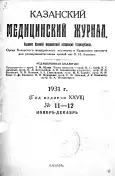About bowel concretions
- Authors: Ognev B.V.1
-
Affiliations:
- Naberezhnye Chelny Hospital Tatrepubliki
- Issue: Vol 27, No 11-12 (1931)
- Pages: 1104-1115
- Section: Articles
- URL: https://journals.rcsi.science/kazanmedj/article/view/84531
- DOI: https://doi.org/10.17816/kazmj84531
- ID: 84531
Cite item
Full Text
Abstract
Intestinal concretions, occurring relatively often in animals, are very rare in humans. The painful form caused by intestinal stones was first described by French authors and in particular Dieulafoy. The name intestinal stones refers to stones formed in the intestine itself, completely without touching here the gallstones that get here from the gallbladder and bile ducts and are mistaken for enteroliths. Fürstenberg in 1844, working on animal enteroliths, divided them into two large groups: true enteroliths, consisting mainly of inorganic compounds, and concretions. The latter, in turn, he divided into phytobezoars (Phytobezoare), hair tumors (Pilobezoare) and mixed, depending on what prevails in the composition of enterolith. Enteroliths are very common in animals, especially in a horse, in which they can reach a huge size without affecting its health. Such large enteroliths should include the 10 klg enterolith described in the literature. weighing and in a circumference of 58 cm, in addition, Kosorotov observed a bezoar in a horse in the colon of 18 pounds, and Schokke isolated 16 intestinal stones in a horse weighing 20.9 klg.
Keywords
Full Text
##article.viewOnOriginalSite##About the authors
B. V. Ognev
Naberezhnye Chelny Hospital Tatrepubliki
Author for correspondence.
Email: info@eco-vector.com
Surgical Department
Russian Federation, Naberezhnye ChelnyReferences
Supplementary files






